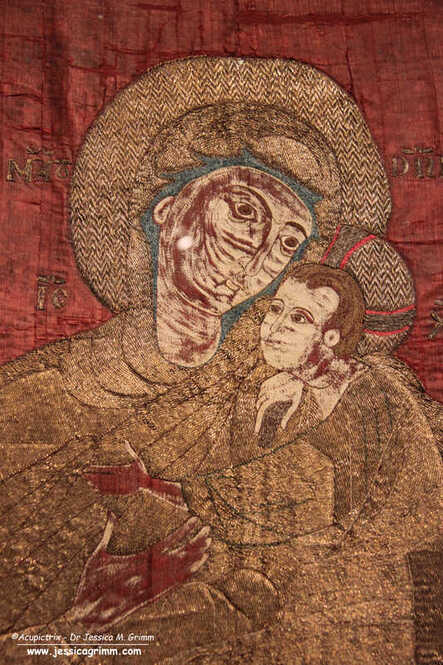|
Last week, we looked into the history and the different parts of the Grandson Antependium. This week, we will have a closer look at the actual embroidery techniques used to produce the piece around AD 1300. As I needed to try out a new mixture of pounce powder, I even worked a small sample of freehand pattern couching. Journeyman and Master Patrons will be able to download PDF instructions with lots of tips and tricks. Medieval goldwork embroidery is perfect for beginners as the techniques are simple and quite forgiving! This Saturday 23-09-23, I will meet with my Master Patrons for a Zoom lecture with Q&A on the Grandson Antependium. If this interests you, please consider becoming a Patron. It helps me cover the bills and do my research into medieval goldwork embroidery. And now, onto some early 14th-century stitching! The central part of the embroidery is worked on a layer of waxed purple silk (tabby weave) backed with a layer of linen. The two components of the purple have not aged in equal measure, resulting in the silk now looking more red than purple. The original colour can be glimpsed along the edge of the halo of the angel where some of the goldwork embroidery has come undone. The goldwork and the silk embroidery are worked through both layers of fabric. As you can see in the picture of the angel above, the silk embroidery mainly consists of directional split stitch. This technique is often associated with Opus anglicanum. However, it was also used in other parts of Europe and bordering Asia at this time. The other technique extensively used on the central part of the Antependium is surface couching over two parallel gold threads (gilded silver, yellow silken core). And although I think that there are possibly only two different couching patterns present, they are used to great effect. By following the contours of the drapery, the simple bricking pattern can change its appearance drastically. The way the light plays of gold threads that are laid in different directions accounts for different hues and thus movement in the design. The other couching pattern used is a nine-step chevron. As the chevron pattern isn't entirely regular, I suspect it was not drawn onto the embroidery fabric. With practice, a master embroiderer probably becomes quite good at keeping the pattern regular and simply does not need to go through the hassle of transferring the pattern onto the embroidery fabric first. Also, as soon as the chevron pattern is worked to follow the shape of the design, drawing it out first is probably almost as complicated as just stitching it. But I might be wrong and there might be guidelines underneath the gold. The two side parts were clearly not made by the same embroidery workshop. Firstly, the embroidery fabric is different: it is a red silk twill. And the embroidery technique is very different too: underside couching with a pair of gold threads (gilded silver, yellow silken core). In order to see the different parts of the design clearly, the direction of the gold threads is changed. Not unlike the method used in the central part of the design.
One of the things that keeps puzzling me when I see this composite piece is how different in age the three pieces look. The central part looks so much older than the two side parts. Is this just due to the difference in materials and techniques used? Or are the side parts of a later date? What do you think? Literature Martiniani-Reber, Marielle (2007): An exceptional piece of embroidery held in Switzerland: the Grandson Antependium. In Matteo Campagnolo, Marielle Martiniani-Reber (Eds.): From Aphrodite to Melusine: Reflections on the Archaeology and the History of Cyprus. Geneva: La pomme d'Or, pp. 85–89. Schuette, Marie; Müller-Christensen, Sigrid (1963): Das Stickereiwerk. Tübingen: Wasmmuth.
2 Comments
Victoria Wood
18/9/2023 22:53:43
I think the center panel is older than the two side panels, and not just due to the different materials used. They were definitely NOT made originally as a set, and I assume the center panel was the original piece, as you can see where the two side panels have been cut down to match the size of the center panel. I wonder if there were originally side panels that matched the center in technique and materials, and those panels somehow deteriorated beyond proper use or repair, then they searched for other panels to adapt and substitute for the damaged originals.
Reply
Your comment will be posted after it is approved.
Leave a Reply. |
Want to keep up with my embroidery adventures? Sign up for my weekly Newsletter to get notified of new blogs, courses and workshops!
Liked my blog? Please consider making a donation or becoming a Patron so that I can keep up the good work and my blog ad-free!
Categories
All
Archives
July 2024
|
Contact: info(at)jessicagrimm.com
Copyright Dr Jessica M. Grimm - Mandlweg 3, 82488 Ettal, Deutschland - +49(0)8822 2782219 (Monday, Tuesday, Friday & Saturday 9.00-17.00 CET)
Impressum - Legal Notice - Datenschutzerklärung - Privacy Policy - Webshop ABG - Widerrufsrecht - Disclaimer
Copyright Dr Jessica M. Grimm - Mandlweg 3, 82488 Ettal, Deutschland - +49(0)8822 2782219 (Monday, Tuesday, Friday & Saturday 9.00-17.00 CET)
Impressum - Legal Notice - Datenschutzerklärung - Privacy Policy - Webshop ABG - Widerrufsrecht - Disclaimer









 RSS Feed
RSS Feed